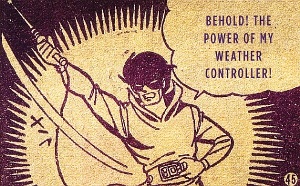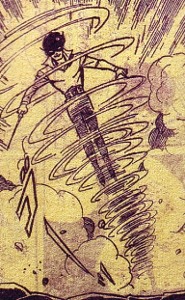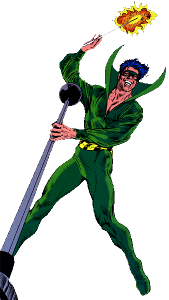Nixgame has a set of screenshots from a canceled game based around the Flash. BottleRocket Entertainment was reportedly building the game for Brash Entertainment, and the project was canceled when Brash went out of business.
Category Archives: Flash History
Flash and the Mechanical Brain
A recent post at Crimson Lightning with a boxy golden-age robot reminded me of this design from Flash Comics #52, “The Machine that Thinks Like a Man.”
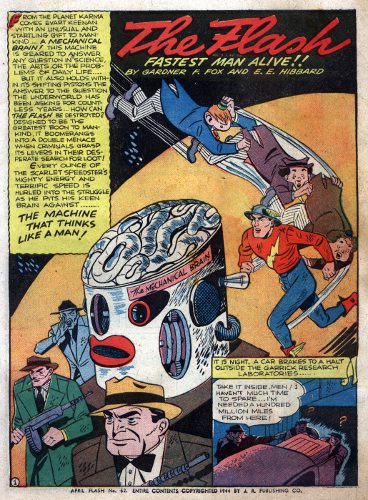
The “mechanical brain” was basically a computer, but of course back in the 1940s, computers were mostly stuck in the realm of science-fiction (except for the occasional warehouse-sized monstrosity with less computing power than a modern calculator). It was built by scientific genius Evart Keenan, a recurring character who left Earth for the alien planet Karma so that his inventions wouldn’t call into the wrong hands. Oddly enough, his first appearance leads directly into the first appearance of the Thinker!
Beyond the Speed of Sound
For those who have been wondering whether the original Flash, Jay Garrick, could exceed the speed of sound back in the Golden Age of comics…
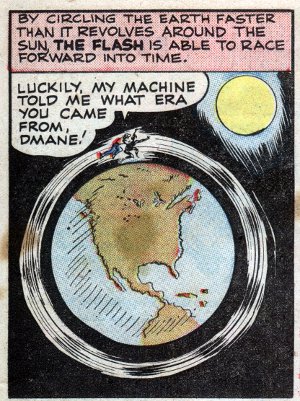
Yes he could.
The speed of sound is roughly 340 meters per second (varying with humidity, altitude, etc.)
Earth revolves around the sun at roughly 30 kilometers per second.
So in that panel he was running at least 88 times as fast as the Flash: Rebirth promo claims was his top speed before he met Barry Allen.
Source: Flash Comics Miniature Edition (promo book taped to boxes of Wheaties in 1946), in which the Flash goes up against the one-off “Criminal From Tomorrow!” Dmane. And yes, that looks like the same stunt Superman pulled in the 1978 movie with Christopher Reeve.
I seem to remember that Jay reached the same levels of insanely impractical speeds that Barry did on a regular basis — this was just the first place I thought to look, since I remembered the time travel element.
Speed Reading: Barry, Daphne, Mopee and Hippies
Progressive Ruin looks into a forgotten Flash supporting cast member — Mopee — and a surprise find in the old Flash comics letters column: a letter from a fan named Cary Bates!
4thletter! bemoans the fact that Barry Allen’s return appears to be linked to another speedster’s death.
Comic Coverage looks at an editor’s excuse for a then-shocking swear word appearing on the cover of a 1960s Flash comic.
Death in Comics is clearly on the collective mind of the blogosphere, with (again) 4thLetter weighing in.
And finally, Heroes’ Brea Grant posts this fan picture of Daphne, Flash and Quicksilver by Drawing Power:
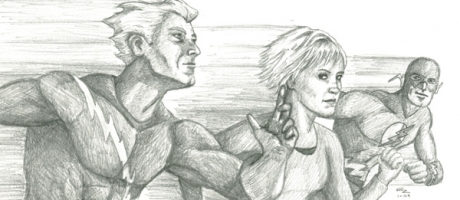
Secret Identities on Trial
This week, The Flash: Emergency Stop hits the shelves. The trade paperback covers half of the year-long Grant Morrison/Mark Millar run from the late 1990s, and, according to solicitations, features the conclusion of “Three of a Kind.” This three-part crossover between Green Lantern, Green Arrow, and The Flash features the second– and third-generation heroes Kyle Rayner, Connor Hawke, and Wally West. Villains Heat Wave, Sonar, and Hatchet attack a cruise liner in which Dr. Polaris is being secretly transported, only to find the three heroes have booked a vacation on the same ship.*
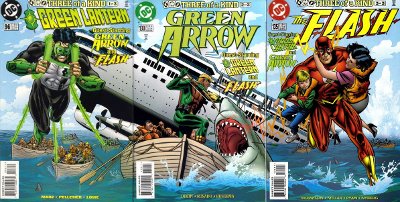
The segment in The Flash v.2 #135 focuses on the villains’ trial, with flashbacks to the incident. At the time, Wally West’s identity was public knowledge, though he testified in full costume. This in itself is unusual given standard courtroom dress codes (a skin-tight bright red costume isn’t exactly conservative business attire, and tends to stand out a bit). But then Green Lantern takes the witness stand:
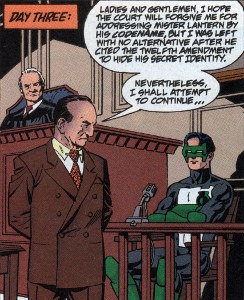
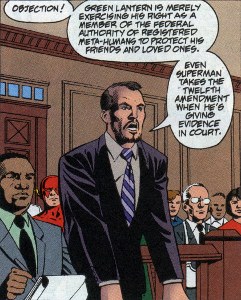
The usage is similar to the U.S. Constitution’s 5th Amendment, which states in part that “No person…shall be compelled in any criminal case to be a witness against himself.” Two things can be gathered from these panels:
- The DC Universe had a “Federal Authority of Registered Meta-Humans” years before Marvel’s Civil War (though after the first story with the Mutant Registration Act).
- The DCU version of the United States Constitution has a Twelfth Amendment which, under some circumstances, allows witnesses to give an alias rather than a real name when testifying in court.
There’s no indication that it’s required to register, or whether it’s simply a good idea if you want legal backing. It’s not even clear whether heroes have to register under their real names. I can’t remember whether any other books made reference to this authority, but suddenly I really want to find and reread my back issues of Chase.
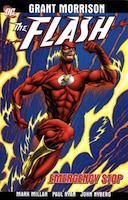 In the real world, the Twelfth Amendment dates back to 1803 (passed 1804) and changes the way the President and Vice-President are elected. Assuming the DCU’s US just has one more Constitutional amendment than we do, their Twelfth would be just about as old, which leads to the question: Why did they need to amend the supreme law of the land to allow masked heroes to testify 130 years before the Golden Age of super-heroes?
In the real world, the Twelfth Amendment dates back to 1803 (passed 1804) and changes the way the President and Vice-President are elected. Assuming the DCU’s US just has one more Constitutional amendment than we do, their Twelfth would be just about as old, which leads to the question: Why did they need to amend the supreme law of the land to allow masked heroes to testify 130 years before the Golden Age of super-heroes?
Thinking about it, though, DC does have super-heroes whose adventures take place in earlier eras, especially in North America. Not just heroes of the Western genre like Jonah Hex or Bat Lash, but classical super-heroes with masks, costumes and powers. Max Mercury’s origin dates back to the early 1800s, for instance, and Miss Liberty (an ancestor of Jesse Quick/Liberty Belle) fought in the American Revolution.
Might the early United States in the DC Universe have decided it was worth letting some of their more colorful national heroes remain pseudonymous even in legal proceedings? It’s certainly possible.
Whatever the circumstances of its passage, it sheds some light on the otherwise nonsensical fact that Barry Allen kept his mask on and his identity secret from his arrest all the way through his trial for manslaughter in the case of Professor Zoom’s death, dissected in great detail by Bob Ingersoll.

*It’s a little more complicated than that, of course.
Weather Wizard, Meet…Go-Go the Magician!
Flash (and Rogues’ Gallery) fan liabrown found something Flashy in Bat-Manga!: a villain who bears a very strong resemblance to Central City’s own Weather Wizard.
As she puts it:
The Japanese artist said he was given some Batman comics and told to replicate the feel of them in manga style, but he pretty much copied Detective Comics #353 for the Go-Go story…with one major difference (mentioned below). He also used Clayface in a story, and some villains who appear to be fairly original (although one is somewhat reminiscent of Gorilla Grodd), including the awesome Lord Death Man.
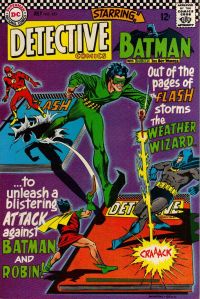 It’s not clear why the artist replaced the Weather Wizard with a new villain, though the comment thread speculates that rights may have had something to do with it — or what “Go-Go” has to do with weather control. (Of course, this was the era of go-go checks on DC’s covers.)
It’s not clear why the artist replaced the Weather Wizard with a new villain, though the comment thread speculates that rights may have had something to do with it — or what “Go-Go” has to do with weather control. (Of course, this was the era of go-go checks on DC’s covers.)
Speaking of Detective Comics #353, it’s got a great classic cover showing the Weather Wizard physically stepping out of a Flash comic book and into an issue of Detective Comics.
More scans — of both the original and the manga versions — are available at the flash_rogues post.

